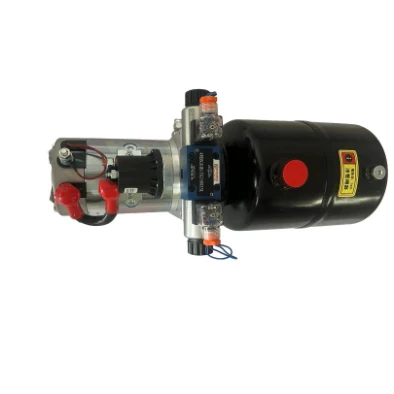Dec . 11, 2024 10:24 Back to list
Manual Hydraulic Lift Cylinder Manufacturing and Quality Assurance Process Overview
Understanding Manual Hydraulic Lift Cylinder Factories
In the world of mechanical engineering and heavy lifting, hydraulic lift cylinders play a crucial role. Designed to perform tasks that require lifting or lowering heavy loads with ease, these devices utilize fluid pressure to generate force. Among the various types of hydraulic systems, the manual hydraulic lift cylinder stands out for its reliability, simplicity, and cost-effectiveness. In this article, we will explore the manufacturing process of manual hydraulic lift cylinders, the benefits they offer, and the factors to consider when choosing a factory for production.
The Basics of Manual Hydraulic Lift Cylinders
At its core, a hydraulic lift cylinder is composed of a cylinder, piston, and hydraulic fluid. Unlike electric or pneumatic systems, manual hydraulic lift cylinders require human operation to function. Users typically operate these cylinders with a pump handle, pulling fluid from a reservoir into the cylinder, causing the piston to rise. This mechanism is advantageous for environments where electric power is not readily available, or where a simpler, more economical solution is preferred.
The Manufacturing Process
The manufacturing process of manual hydraulic lift cylinders involves various stages, each requiring precision engineering. Here is a brief overview of the steps involved
1. Design and Engineering The first stage involves creating detailed designs and specifications using CAD software. Engineers consider factors like load capacity, dimensions, and material types to ensure that the final product meets safety standards.
2. Material Selection High-quality materials are crucial for durability and performance. Common materials include high-strength steel for the cylinder and piston, along with seals and gaskets made of rubber or other durable substances to prevent leaks.
3. Machining The selected materials undergo machining processes such as turning, milling, and grinding. This process shapes the components with high precision, ensuring that they fit together seamlessly.
4. Assembly Once all parts are machined, they are prepared for assembly. The cylinder, piston, seals, and other components are assembled in a clean environment to avoid contamination.
5. Testing After assembly, each hydraulic lift cylinder is subjected to rigorous testing. This includes pressure tests, load tests, and functional tests to ensure that every unit meets performance standards and safety regulations.
6. Finishing Finally, the cylinders are treated with protective coatings to prevent corrosion and improve aesthetics. These finishes enhance the longevity and appearance of the hydraulic lift cylinders.
Benefits of Manual Hydraulic Lift Cylinders
manual hydraulic lift cylinder factory

Manual hydraulic lift cylinders offer several advantages that make them an excellent choice in numerous applications
- Cost-Effective Compared to electric or pneumatic systems, manual hydraulic cylinders are generally more affordable. They require less investment in terms of both initial purchase and maintenance costs.
- Simplicity Their straightforward design means they are easy to operate and maintain. Users can quickly learn to use these systems without needing specialized training.
- Versatility Manual hydraulic lift cylinders can be employed in various settings, including workshops, warehouses, and construction sites. They are effective for lifting heavy machinery, equipment, and materials.
- Safety When operated correctly, manual hydraulic lift cylinders provide a safe lifting solution. The absence of electrical components reduces the risk of electrical hazards, making them ideal for outdoor or damp environments.
Choosing a Hydraulic Lift Cylinder Factory
When selecting a factory for manual hydraulic lift cylinders, consider the following factors
- Reputation and Experience Look for manufacturers with a proven track record in the industry. Check reviews and testimonials from previous customers.
- Quality Control Ensure the factory follows stringent quality control processes to guarantee that each unit meets specified standards.
- Customization Options Assess whether the factory can accommodate specific requirements for size, load capacity, or additional features tailored to your needs.
- Warranty and After-Sales Support A reliable manufacturer offers warranties on their products and provides robust after-sales support, ensuring customer satisfaction.
In conclusion, manual hydraulic lift cylinder factories play a vital role in producing these essential tools that enhance productivity in various industries. Understanding the manufacturing process, the benefits of these devices, and the selection criteria for choosing a factory can lead to informed decisions that improve operational efficiency and safety.
-
1.5 Ton Flipping Oil Cylinder 70/82-40-217-720-Hebei Shenghan Hydraulic Machinery|Precision Hydraulic Cylinder,Custom Hydraulic Solutions
NewsAug.29,2025
-
1.5 Ton Flipping Oil Cylinder 70/82-40-217-720 | Hebei Shenghan Hydraulic Machinery Co., Ltd.
NewsAug.29,2025
-
High-Precision [90/105-50-180-480] Industrial Component | Durable & Reliable
NewsAug.27,2025
-
High-Performance Set of 50/60-45-290 471 | Durable & Reliable Components
NewsAug.26,2025
-
Efficient Pallet Truck Power Units - Reliable Hydraulic Systems
NewsAug.25,2025
-
Premium Set of 50/60-45-290 471 Parts | High Performance
NewsAug.24,2025
